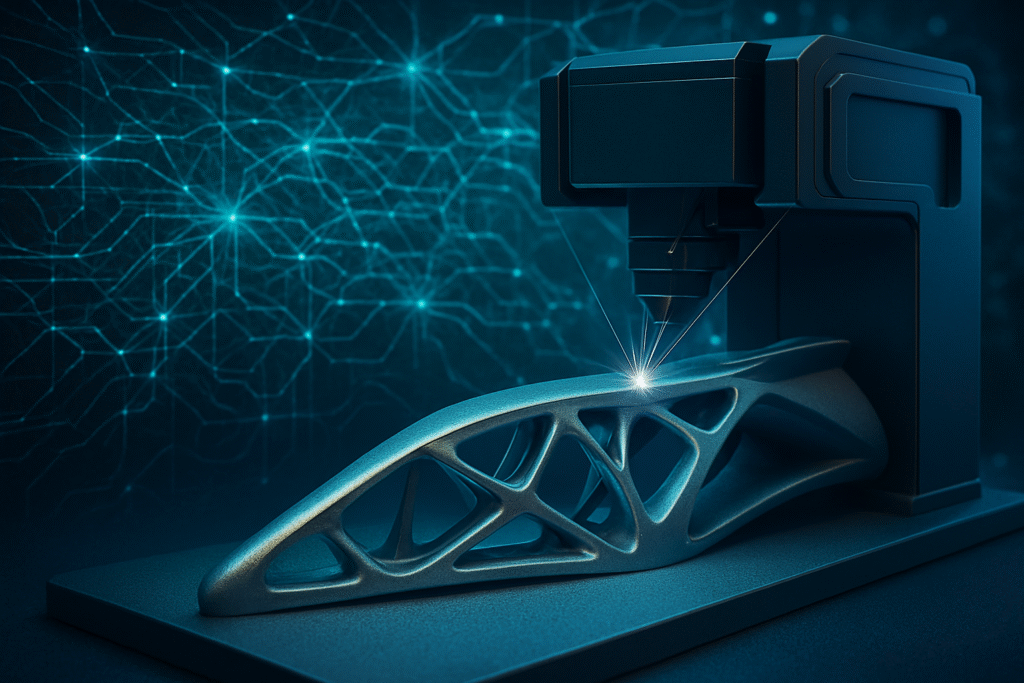
The convergence of Artificial Intelligence (AI) and additive manufacturing (AM), often known as 3D printing, is poised to fundamentally revolutionize the production of custom submarine and aircraft components, marking a pivotal moment for military readiness and technological superiority. This powerful synergy promises to dramatically accelerate design cycles, enable on-demand manufacturing in challenging environments, and enhance the performance and resilience of critical defense systems. The immediate significance lies in its capacity to address long-standing challenges in defense logistics and supply chain vulnerabilities, offering a new paradigm for rapid innovation and operational agility.
This integration is not merely an incremental improvement; it's a strategic shift that allows for the creation of complex, optimized parts that were previously impossible to produce. By leveraging AI to guide and enhance every stage of the additive manufacturing process, from initial design to final quality assurance, the defense sector can achieve unprecedented levels of customization, efficiency, and responsiveness. This capability is critical for maintaining a technological edge in a rapidly evolving global security landscape, ensuring that military forces can adapt swiftly to new threats and operational demands.
Technical Prowess: AI's Precision in Manufacturing
AI advancements are profoundly transforming additive manufacturing for custom defense components, offering significant improvements in design optimization, process control, and material science compared to traditional methods. Through machine learning (ML) and other AI techniques, the defense industry can achieve faster production, enhanced performance, reduced costs, and greater adaptability.
In design optimization, AI, particularly through generative design (GD), is revolutionizing how defense components are conceived. Algorithms can rapidly generate and evaluate a multitude of design options based on predefined performance criteria, material properties, and manufacturing constraints. This allows for the creation of highly intricate geometries, such as internal lattice structures and conformal cooling channels, which are challenging with conventional manufacturing. These AI-driven designs can lead to significant weight reduction while maintaining or increasing strength, crucial for aerospace and defense applications. This approach drastically reduces design cycles and time-to-market by automating complex procedures, a stark contrast to the slow, iterative process of manual CAD modeling.
For process control, AI is critical for real-time monitoring, adjustment, and quality assurance during the AM process. AI systems continuously monitor printing parameters like laser power and material flow using real-time sensor data, fine-tuning variables to maintain consistent part quality and minimize defects. Machine learning algorithms can accurately predict the size and position of anomalies during printing, allowing for proactive adjustments to prevent costly failures. This proactive, highly precise approach to quality control, often utilizing AI-driven computer vision, significantly improves accuracy and consistency compared to traditional human-dependent inspections.
Furthermore, AI is accelerating material science, driving the discovery, development, and qualification of new materials for defense. AI-driven models can anticipate the physical and chemical characteristics of alloys, facilitating the refinement of existing materials and the invention of novel ones, including those capable of withstanding extreme conditions like the high temperatures required for hypersonic vehicles. By using techniques like Bayesian optimization, AI can rapidly identify optimal processing conditions, exploring thousands of configurations virtually before physical tests, dramatically cutting down the laborious trial-and-error phase in material research and development. This provides critical insights into the fundamental physics of AM processes, identifying predictive pathways for optimizing material quality.
Reshaping the Industrial Landscape: Impact on Companies
The integration of AI and additive manufacturing for defense components is fundamentally reshaping the competitive landscape, creating both immense opportunities and significant challenges for AI companies, tech giants, and startups. The global AI market in aerospace and defense alone is projected to grow from approximately $28 billion today to $65 billion by 2034, underscoring the lucrative nature of this convergence.
AI companies specializing in industrial AI, machine learning for materials science, and computer vision stand to benefit immensely. Their core offerings are crucial for optimizing design (e.g., Autodesk [NASDAQ: ADSK], nTopology), predicting material behavior, and ensuring quality control in 3D printing. Companies like Aibuild and 3D Systems [NYSE: DDD] are developing AI-powered software platforms for automated toolpath generation and overall AM process automation, positioning themselves as critical enablers of next-generation defense manufacturing.
Tech giants with extensive resources in cloud computing, AI research, and data infrastructure, such as Alphabet (Google) [NASDAQ: GOOGL], Microsoft [NASDAQ: MSFT], and Amazon (AWS) [NASDAQ: AMZN], are uniquely positioned to capitalize. They provide the essential cloud backbone for the massive datasets generated by AI-driven AM and can leverage their advanced AI research to develop sophisticated generative design tools and simulation platforms. These giants can offer integrated, end-to-end solutions, often through strategic partnerships or acquisitions of defense tech startups, intensifying competition and potentially making traditional defense contractors more reliant on their digital capabilities.
Startups often drive innovation and can fill niche gaps. Agile companies like Divergent Technologies Inc. are already using AI and 3D printing to produce aerospace components with drastically reduced part counts. Firestorm Labs is deploying mobile additive manufacturing stations to produce drones and parts in expeditionary environments, demonstrating how startups can introduce disruptive technologies. While they face challenges in scaling and certification, venture capital funding in defense tech is attracting significant investment, allowing specialized startups to focus on rapid prototyping and niche solutions where agility and customization are paramount. Companies like Markforged [NYSE: MKFG] and SPEE3D are also key players in deployable printing systems.
The overall competitive landscape will be characterized by increased collaboration between AI firms, AM providers, and traditional defense contractors like Lockheed Martin [NYSE: LMT] and Boeing [NYSE: BA]. There will also be potential consolidation as larger entities acquire innovative startups. This shift towards data-driven manufacturing and a DoD increasingly open to non-traditional defense companies will lead to new entrants and a redefinition of market positioning, with AI and AM companies becoming strategic partners for governments and prime contractors.
A New Era of Strategic Readiness: Wider Significance
The integration of AI with additive manufacturing for defense components signifies a profound shift, deeply embedded within broader AI trends and poised to redefine strategic readiness. This convergence is a cornerstone of Industry 40 and smart factories in the defense sector, leveraging AI for unprecedented efficiency, real-time monitoring, and data-driven decision-making. It aligns with the rise of generative AI, where algorithms autonomously create complex designs, moving beyond mere analysis to proactive, intelligent creation. The use of AI for predictive maintenance and supply chain optimization also mirrors the widespread application of predictive analytics across industries.
The impacts are transformative: operational paradigms are shifting towards rapid deployment of customized solutions, vastly improving maintenance of aging equipment, and accelerating the development of advanced unmanned systems. This offers a significant strategic advantage by enabling faster innovation, superior component production, and enhanced supply chain resilience in a volatile global landscape. The emergence of "dual-use factories" capable of switching between commercial and defense production highlights the economic and strategic flexibility offered. However, this also necessitates a workforce evolution, as automation creates new, tech-savvy roles demanding specialized skills.
Potential concerns include paramount issues of cybersecurity and intellectual property (IP) protection, given the digital nature of AM designs and AI integration. The lack of fully defined industry standards for 3D printed defense parts remains a hurdle for widespread adoption and certification. Profound ethical and proliferation risks arise from the development of AI-powered autonomous systems, particularly weapons capable of lethal decisions without human intervention, raising complex questions of accountability and the potential for an AI arms race. Furthermore, while AI creates new jobs, it also raises concerns about job displacement in traditional manufacturing roles.
Comparing this to previous AI milestones, this integration represents a distinct evolution. It moves beyond earlier expert systems with predefined rules, leveraging machine learning and deep learning for real-time, adaptive capabilities. Unlike rigid automation, current AI in AM can learn and adapt, making real-time adjustments. It signifies a shift from standalone AI tools to deeply integrated systems across the entire manufacturing lifecycle, from design to supply chain. The transition to generative AI for design, where AI creates optimal structures rather than just analyzing existing ones, marks a significant breakthrough, positioning AI as an indispensable, active participant in physical production rather than just an analytical aid.
The Horizon of Innovation: Future Developments
The convergence of AI and additive manufacturing for defense components is on a trajectory for profound evolution, promising transformative capabilities in both the near and long term. Experts predict a significant acceleration in this domain, driven by strategic imperatives and technological advancements.
In the near term (1-5 years), we can expect accelerated design and optimization, with generative AI rapidly exploring and creating numerous design possibilities, significantly shortening design cycles. Real-time quality control and defect detection will become more sophisticated, with AI-powered systems monitoring AM processes and even enabling rapid re-printing of faulty parts. Predictive maintenance will be further enhanced, leveraging AI algorithms to anticipate machinery faults and facilitate proactive 3D printing of replacements. AI will also streamline supply chain management by predicting demand fluctuations and optimizing logistics, further bolstering resilience through on-demand, localized production. The automation of repetitive tasks and the enhanced creation of digital twins using generative AI will also become more prevalent.
Looking into the long term (5+ years), the vision includes fully autonomous manufacturing cells capable of resilient production in remote or contested environments. AI will revolutionize advanced material development, predicting new alloy chemistries and expanding the materials frontier to include lightweight, high-temperature, and energetic materials for flight hardware. Self-correcting AM processes will emerge, where AI enables 3D printers to detect and correct flaws in real-time. A comprehensive digital product lifecycle, guided by AI, will provide deep insights into AM processes from end-to-end. Furthermore, generative AI will play a pivotal role in creating adaptive autonomous systems, allowing drones and other platforms to make on-the-fly decisions. A strategic development is the establishment of "dual-use factories" that can rapidly pivot between commercial and defense production, leveraging AI and AM for national security needs.
Potential applications are vast, encompassing lightweight, high-strength parts for aircraft and spacecraft, unique replacement components for naval vessels, optimized structures for ground vehicles, and rapid production of parts for unmanned systems. AI-driven AM will also be critical for stealth technology, advanced camouflage, electronic warfare systems, and enhancing training and simulation environments by creating dynamic scenarios.
However, several challenges need to be addressed. The complexity of AM processing parameters and the current fragmentation of data across different machine OEMs hinder AI's full potential, necessitating standardized data lakes. Rigorous qualification and certification processes for AM parts in highly regulated defense applications remain crucial, with a shift from "can we print it?" to "can we certify and supply it at scale?" Security, confidentiality, high initial investment, and workforce development are also critical hurdles.
Despite these challenges, expert predictions are overwhelmingly optimistic. The global military 3D printing market is projected for significant growth, with a compound annual growth rate (CAGR) of 12.54% from 2025–2034, and AI in defense technologies is expected to see a CAGR of over 15% through 2030. Industry leaders believe 3D printing will become standard in defense within the next decade, driven by surging investment. The long-term vision includes a digital supply chain where defense contractors provide digital 3D CAD models rather than physical parts, reducing inventory and warehouse costs. The integration of AI into defense strategies is considered a "strategic imperative" for maintaining military superiority.
A Transformative Leap for Defense: Comprehensive Wrap-up
The fusion of Artificial Intelligence and additive manufacturing represents a groundbreaking advancement, poised to redefine military readiness and industrial capabilities for decades to come. This powerful synergy is not merely a technological upgrade but a strategic revolution that promises to deliver unprecedented agility, efficiency, and resilience to the defense sector.
The key takeaways underscore AI's pivotal role in accelerating design, enhancing manufacturing precision, bolstering supply chain resilience through on-demand production, and ultimately reducing costs while fostering sustainability. From generative design creating optimal, complex geometries to real-time quality control and predictive maintenance, AI is transforming every facet of the additive manufacturing lifecycle for critical defense components.
In the annals of AI history, this development marks a significant shift from analytical AI to truly generative and real-time autonomous control over physical production. It signifies AI's evolution from a data-processing tool to an active participant in shaping the material world, pushing the boundaries of what is manufacturable and achievable. This integration positions AI as an indispensable enabler of advanced manufacturing and a core component of national security.
The long-term impact will be a defense ecosystem characterized by unparalleled responsiveness, where military forces can rapidly innovate, produce, and repair equipment closer to the point of need. This will lead to a fundamental redefinition of military sustainment, moving towards digital inventories and highly adaptive supply chains. The strategic geopolitical implications are profound, as nations leveraging this technology will gain significant advantages in maintaining technological superiority and industrial resilience. However, this also necessitates careful consideration of ethical frameworks, regulatory standards, and robust cybersecurity measures to manage the increased autonomy and complexity.
In the coming weeks and months, watch for further integration of AI with robotics and automation in defense manufacturing, alongside advancements in Explainable AI (XAI) to ensure transparency and trust. Expect concrete steps towards establishing dual-use factories and continued efforts to standardize AM processes and materials. Increased investment in R&D and the continued prototyping and deployment of AI-designed, 3D-printed drones will be key indicators of this technology's accelerating adoption. The convergence of AI and additive manufacturing is more than a trend; it is a strategic imperative that promises to reshape the future of defense.
This content is intended for informational purposes only and represents analysis of current AI developments.
TokenRing AI delivers enterprise-grade solutions for multi-agent AI workflow orchestration, AI-powered development tools, and seamless remote collaboration platforms. For more information, visit https://www.tokenring.ai/.





